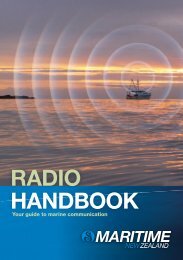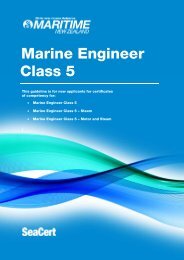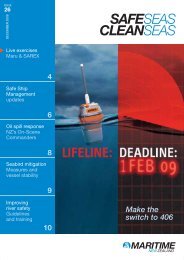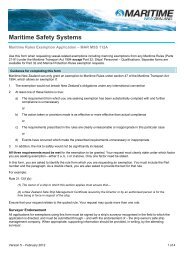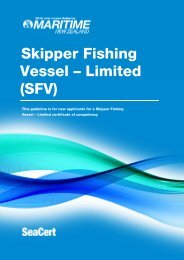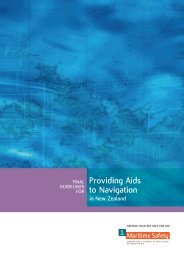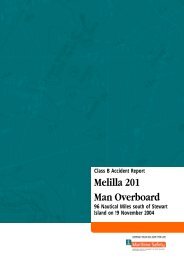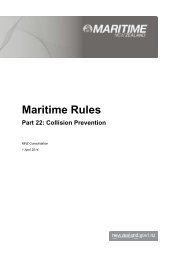New Zealand oil spill response strategy - Maritime New Zealand
New Zealand oil spill response strategy - Maritime New Zealand
New Zealand oil spill response strategy - Maritime New Zealand
Create successful ePaper yourself
Turn your PDF publications into a flip-book with our unique Google optimized e-Paper software.
Spill Consequences<br />
A framework for assessing the consequences of <strong>oil</strong> <strong>spill</strong>s on coastlines has been developed based on<br />
earlier work. For this exercise, <strong>New</strong> <strong>Zealand</strong> is divided into a number of 20 km2 ‘coastal cells’, and<br />
each cell is rated using a scale that assesses the vulnerability of the area to <strong>oil</strong> <strong>spill</strong>s in terms of<br />
environmental factors (i.e. shoreline character, plants and animals) and human factors (i.e. economic,<br />
cultural, social, economic and recreational). These ratings produce a profile for each cell that<br />
contributes to the national map (below).<br />
The areas that are of greatest environmental concern are those that have a high socio-economic value,<br />
have shoreline types that are very sensitive to <strong>oil</strong> <strong>spill</strong>s (e.g. mangroves in the Auckland region) or<br />
those that contain important wildlife (e.g. birdlife on Farewell Spit).<br />
Ports are hot spots. The economic resources, human population and recreation areas located in and<br />
around Auckland’s ports contribute to that region showing as a hot spot. Also, the <strong>spill</strong> rate for ports<br />
is around 3 times higher than the <strong>spill</strong> rate for the combined coastal areas. The higher <strong>spill</strong> rate for<br />
ports reflects the greater risks associated with vessel movements in and out of harbours and the<br />
transfer of <strong>oil</strong> cargo and fuel. For NZ ports, Auckland has the highest <strong>spill</strong> rate, followed by Marsden<br />
Point, Lyttlelton and Wellington. The Auckland rate reflects the high level of activity and the large range<br />
of vessels using the port.<br />
Contingent Capability<br />
<strong>Maritime</strong> <strong>New</strong> <strong>Zealand</strong>, in conjunction with its various national and international partners, will respond<br />
to a <strong>spill</strong> of any size. However, it is more cost-effective for <strong>New</strong> <strong>Zealand</strong> to maintain a <strong>response</strong><br />
capability for the most likely <strong>spill</strong>s, and be able to call on other countries for extra equipment and<br />
trained personnel when needed for major <strong>spill</strong>s. <strong>New</strong> <strong>Zealand</strong> has developed a domestic <strong>response</strong><br />
capability for a ‘one-in-a-hundred’ year event based on successive risk assessments. The actual <strong>spill</strong><br />
size planned for is impossible to specify, since there are too many variables to ascertain a credible<br />
estimated figure.<br />
8





